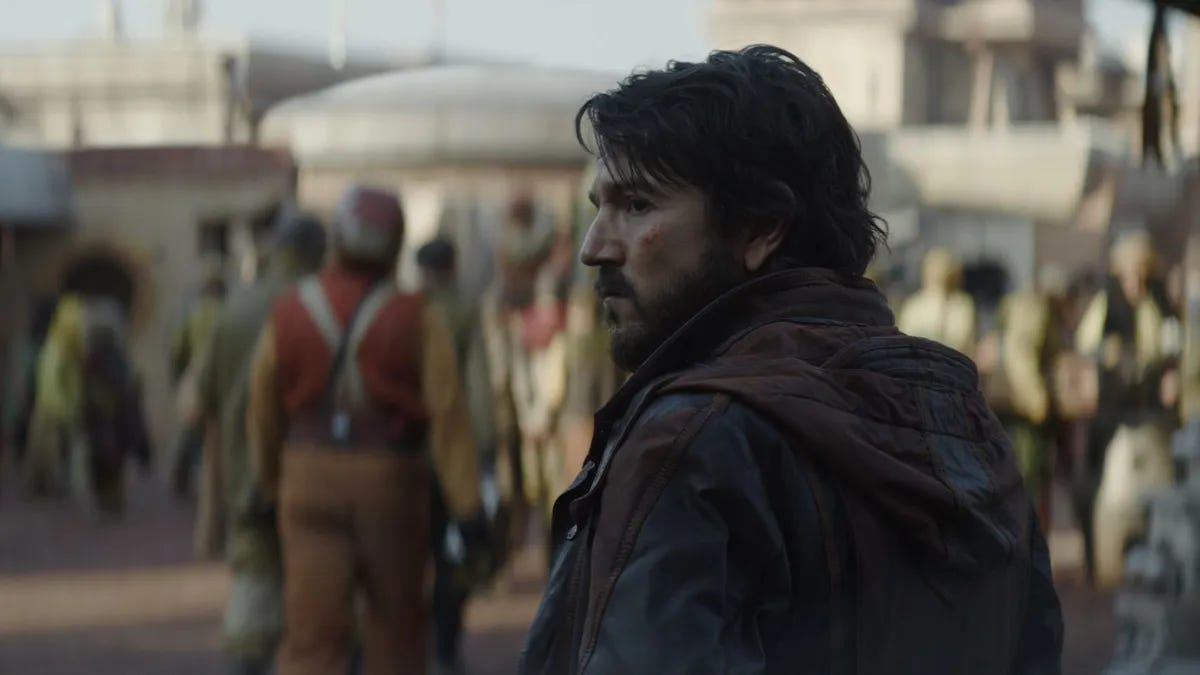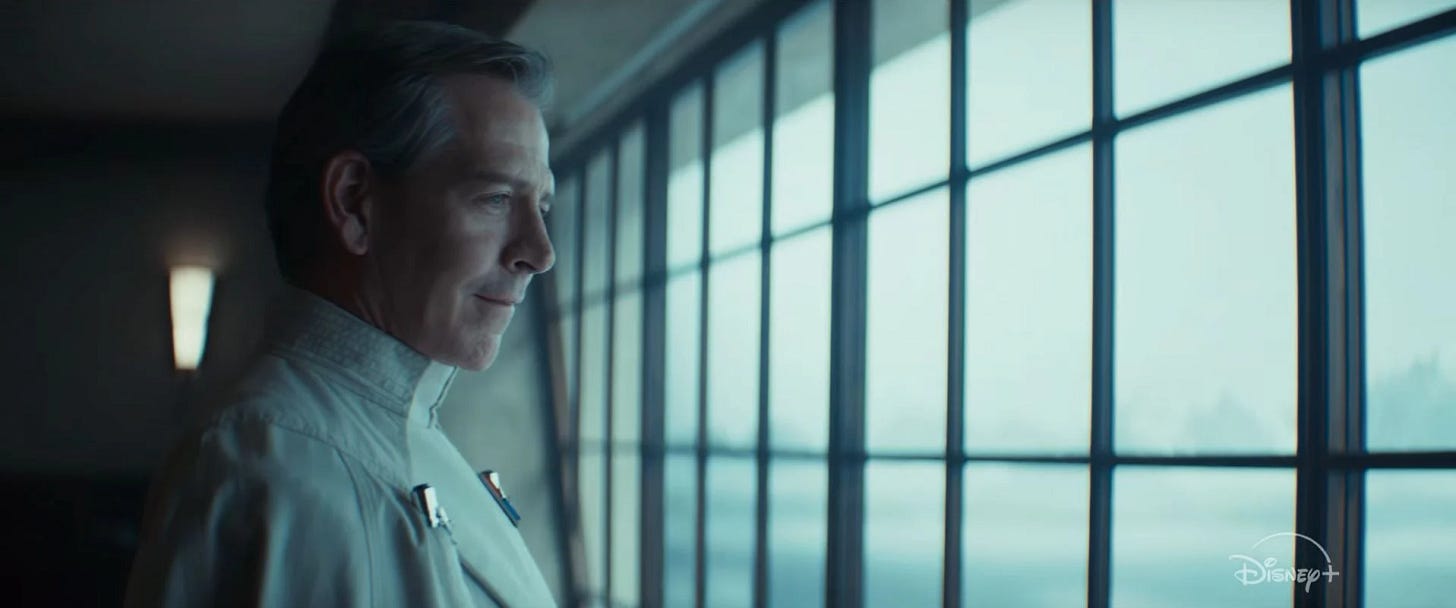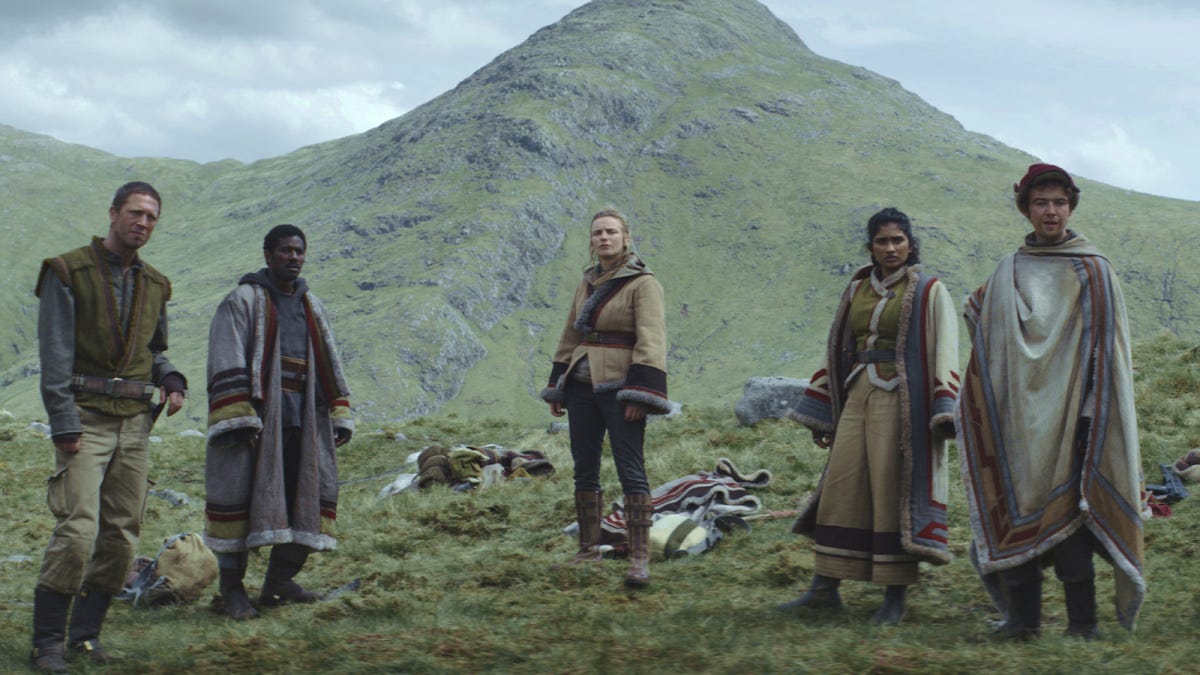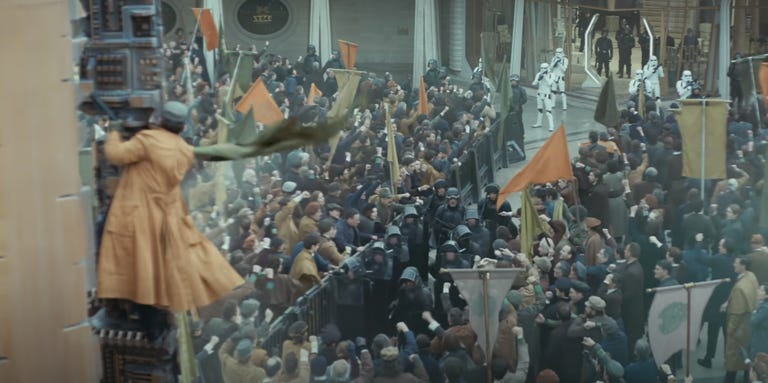Andor
part one | a storytelling guide for resistance movements
spoilers ahead
Back in 2022, I remember being unreservedly floored by Andor— a masterpiece of a series with deliberate pacing, genius writing, and storytelling that was nothing short of riveting. I was, however, confused—just as much as I was compelled. How was this airing on Disney+? Of all places? The platform seemed almost antithetical to the show’s premise, largely about the Rebellion’s origins and foundations. From my living room, I’d shout, ‘Disney let them air this?’ after watching one of their gripping insurgencies. Either that, or I felt duped.
All the same, it’s my favorite show to beat. I was so excited when Season Two was on its way. Too excited that I ended up dancing in front of my partner until I ceased and felt gripped by some sense of truth revealed to me in that moment. With clarity and conviction, I turned to him and said:
“Baby.. I figured it out. My purpose in life is Andor.”
:)
So, in the spirit of purpose and devotion, I’d love to share with you some fragments from the copious notes I’ve written and mused over time while watching Andor—traces from my life’s calling. Lol.
This is part one! I hope you enjoy my indulgence below:
The monotony and mundanity of evil
Early in Season Two, a secret meeting takes place in the Maltheen Divide. Krennic and a curated circle of Imperial delegates gathered to discuss Ghorman, a planet known for the booming trade of Ghorman silk—spun by the planet’s native spiders called the ghorlectipods. But Krennic was building up the discussion (in a corny retro fashion) to reveal that he wasn’t exactly fixated on the fabric, but what lies underneath the planet. Kalkite is an ore so potent that it could rewire the Empire’s power altogether, suggesting that the mineral was needed to build or fuel the Death Star. For that, Krennic is prepared to tear through Ghorman to claim it.
The meeting felt tedious and monotone, yet the outcomes being discussed had large-scale, destructive—often fatal—implications. (One delegate even casually mentioned staging a disaster, which made my stomach drop.) And knowing Tony Gilroy, this pace is likely intentional to demonstrate the banalization of evil, a concept popularized by Hannah Arendt in Eichmann in Jerusalem (1963). This notion frames evil not as a monstrous act or demonic spectacle (though it can be that too), but as a phenomenon so disturbingly ordinary it masquerades as the mundane.
Others speak of this similar-enough framework:
Achille Mbembe (necropolitics)
Primo Levi (“Monsters exist, but they are too few in number to be truly dangerous. More dangerous are the common men, the functionaries ready to believe and to act without asking questions.”)
Claudia Card (“Intolerable harm that is culpably produced, sustained, or tolerated by human agents or institutions.”),
… and in a most controversial way, Stanley Milgram with the Milgram experiment.
With the clinical planning of the Ghorman massacre, Andor doesn’t portray the Empire as grandiose villainy, but as bureaucratic horror. It’s not cloaks and lightning bolts—not even the Force—but policy meetings, databases, and the curt exchanges between the Pre-Mor Authority and the ISB that issue and execute orders. The dissonance between the ordinary tone of the meeting and the extraordinary violence they intend to engineer continues to haunt me.
The plurality and porousness within resistance movements
Just because we share the same ideas and visions of freedom, doesn’t mean we will be on the same page about how to get there.
It’s wise to expect that we will be at odds with others during mobilizations, campaigning, and even in something as everyday as communication. Disagreement is not a failure of solidarity, but a sign of plurality. There is no singular body of ‘the resistance,’ no monolith of good intention. We are porous, (self-)contradictory, and ever-shifting. And perhaps that’s not something to fear, but to expect, to navigate through, and even to honor.
Another point worth noting—though I don’t have energy to explore it more in-depth—is that disagreement within grassroots movements is also a sign of being under-resourced. More often than not, conflict arises not from malice or incompetence, but from a lack of adequate information, funding, or networks needed to sustain the work. It’s easy to misdirect frustration in the face of scarcity—toward one another, or even inward. Tension builds, passive aggression festers, and conversations grow sharp. But this isn’t necessarily a failure of the organization; rather, it reflects the difficult terrain of building power with limited tools, from the ground up and even from underground.
But even after we are finally resourced.. even after we win.. there will be some kind of cycle of harm or tension or strife that will resurface. I just hope that by then, we’ve already established the relational infrastructures needed to keep each other accountable— infrastructures that are imagined and built beyond carceral logic and systems.
But I need to remember that unity is not the same as uniformity, and the goal, after all, is to welcome as many choices and distinct selves as we can while fostering collective safety and accountability.
Public and expressive tactics aren’t always effective
Just because the collective action is loud doesn’t mean it will be enough to topple authoritarian power. Some actions speak truth to power. Others outmaneuver it.
I’m not saying we should end our public demonstrations once and for all. We still need protests, marches, manifestos, online statements, and rallies to spread the word about our causes, to expose systemic violations, and to put pressure on the powers-that-be to meet immediate demands. Other than having a clear target and concrete objectives during public actions, the point is to always remember to diversify our tactics—differentiating expressive from instrumental ones—so we can assess which are most useful and have more impact in a given moment and context, all while remaining strategic in the long term.
I was so! mesmerized! seeing how Luthen Rael and Kleya Marki worked strategically and in necessary silence. I especially loved seeing Kleya operate the vintage communication console hidden in the backroom of Luthen's antiquities gallery on Coruscant. Reminiscent of analog radios, the device was crucial for secure transmissions across the galaxy—the machine that quietly helped lay the groundwork for the Rebellion’s roots and rise.
Sometimes, one of the most effective things we can do is be unreadable… or go offline. And we must be honest about which tactics serve visibility, and which serve movement. This also means acknowledging that places like Ghorman—wealthy and relatively resourced planets—have more privilege to protest loudly. More often than not, these communities struggle to discern whether their tactics will effectively advance their goals—or risk backfiring—simply because they’ve rarely had to. And tragically, Deedra understood this dynamic all too well.
Deedra to Krennic: “You need a radical insurgency you can count on.
You need Ghorman rebels you can count on to do the wrong thing.”
That doesn’t mean the Ghorman’s public action was invalid, but we badly need to analyze our opponents—to learn how to think like them, which was what Luthen and Deedra did so exceptionally—and assess the terrain as well as we can. Never mistake volume for value.
What do you think?
I will publish part two in the next few days. For now, I welcome your reflections.
If you enjoyed my Andor indulgence, you can buy me a coffee via Wise or Venmo (@ gabestorres). Because I live outside the States, I can’t get paid for writing on Substack. So, any support comes a long way! More soon. G





